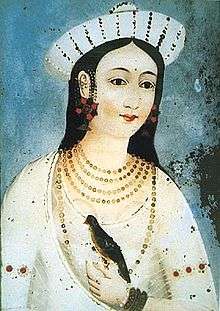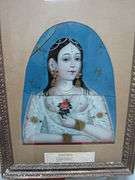Mastani
Mastani (1699–1740 CE) was the daughter of Maharaja Chhatrasal and the second wife of the Maratha Peshwa Bajirao I.[1][2]
Princess Mastani | |
|---|---|
 An artist's impression of Mastani (dated 18th century A.D.) | |
| Born | 29 August 1699 Mau Sahaniya, Bundelkhand |
| Died | 1740 Pabal, Pune |
| Resting place | Pabal |
| Spouse(s) | Baji Rao I |
| Children | Shamsher Bahadur I (Krishna Rao) |
| Parent(s) | Chhatrasal Ruhaani Bai Begum |
Early life
Mastani was born to Maharaja Chhatrasal a Rajput king and his Persian Muslim concubine Ruhaani Bai Begum.[3] Her father was the founder of the Panna State.
She and her father were followers of the Pranami Sampradaya, a Hindu sect based on the Bhakti worship of Sri Krishna.[2]
Biography

Marriage with Bajirao I
In 1728, Muhammad Khan Bangash invaded Chhatrasal's kingdom, defeated him and besieged his capital. Chhatrasal secretly wrote to Bajirao requesting his help. But being occupied in a military campaign in Malwa Bajirao did not respond until 1729 when he marched on towards Bundelkhand. Ultimately Bajirao defeated Bangash after reaching Jaitpur near Kulpahar in present Uttar Pradesh.[4]
In gratitude, Chattrasal gave Bajirao the hand of his daughter Mastani, dominion over Jhansi, Sagar and Kalpi - amounting to a third of his kingdom. After his marriage to Mastani, he also gifted Bajirao with 33 lakh gold coins and a gold mine.[1][5] At the time, Bajirao was already married and monogamous by both nature and family tradition. He, however, accepted out of regard for Chattrasal.[6]
Back in Pune, the marriage was not generally accepted because Mastani's Muslim heritage. Mastani lived for some time with Bajirao at his palace of Shaniwar Wada in the city of Pune. The palace's north-east corner held Mastani Mahal and had its own external doorway called Mastani Darwaza. Because of his family's intolerance of Mastani, Bajirao later built a separate residence for Mastani at Kothrud in 1734,[7] some distance away from Shaniwar Wada. The site still exists at the Mrutyunjay temple on Karve road. The palace at Kothrud was dismantled and parts of this are displayed at a special section of Raja Dinkar Kelkar Museum.[8][7]
Shamsher Bahadur (Krishna Rao)
Mastani bore a son who was named Krishna Rao at birth, within a few months of Bajirao's first wife Kashibai delivering a son. But being born of a half-Muslim mother, the priests refused to conduct the Hindu upanayana ceremony for Krishna Rao. The boy was eventually named Shamsher Bahadur and brought up as a Muslim.[6]
After the closely following deaths of Bajirao and Mastani in 1740, Kashibai took the 6 year-old Shamsher Bahadur under her care and raised him as one of her own. Shamsher was bestowed upon a portion of his father’s dominion of Banda and Kalpi. In 1761, he and his army contingent fought alongside the Peshwa in the Third Battle of Panipat between the Marathas and Afghans. He was wounded in that battle and died a few days later at Deeg.[9]
Death
Mastani died in 1740, shortly after Bajirao's death. Her cause of death is still unknown. Mastani was buried in the village of Pabal. Given her association with both Hinduism and Islam, her grave is called both Mastani's samadhi and Mastani's mazar.[5][10]
Descendants
Shamsher Bahadur's son Nawab Ali Bahadur I was given the Rajputana provinces that came in Mastani's dowry - Jhansi, Sagar and Kalpi. In 1858, during the Indian Rebellion of 1857 his son Nawab Ali Bahadur II responded to a rakhi from Rani Laxmibai of Jhansi and fought against the British.[11][12]Shamsher's successor Ali Bahadur (Krishna Singh) established his authority over large parts of Bundelkhand and became the Nawab of Banda. The descendant of Shamsher Bahadur continued their allegiance to baihi bai fought the English in the Anglo-Maratha War of 1803. His descendant, Ali Bahadur fought alongside with Rani Lakshmibai in First War of Indian Independence of 1857. His descendants were known as Nawabs of Banda. But after the defeat of Ali Bahadur, the British abolished the Banda state. His present descendants lead a simple life in Banda.
In popular culture

Literature
- 1972 - Rau, the Marathi novel by Nagnath S. Inamdar featuring a fictionalized love story between Baji Rao I and Mastani.[13]
Films
- 1955 - Mastana directed by Dhirubhai Desai. It starred Nigar Sultana, Manher Desai, Shahu Modak and Agha.[14]
- 2015 - Bajirao Mastani directed by Sanjay Leela Bhansali based on the Marathi novel Rau. It starred Deepika Padukone, Ranveer Singh and Priyanka Chopra in lead roles.[15]
Television
- 1990 - Rau a Marathi TV series based on the novel by the same name.
- 2015 - Shrimant Peshwa Bajirao Mastani, a Marathi TV serial broadcast on ETV Marathi.[16]
- 2017 - Peshwa Bajirao, a Hindi TV series premiered and broadcast on Sony TV India.
References
- Chopra, Kusum. Mastani. Rupa Publications. ISBN 9788129133304.
- "How Bajirao and Mastani became a byword for doomed romance".
- Sen, Sailendra (2013). A Textbook of Medieval Indian History. Primus Books. pp. 187–188. ISBN 978-9-38060-734-4.
- G.S.Chhabra (1 January 2005). Advance Study in the History of Modern India (Volume-1: 1707-1803). Lotus Press. pp. 19–28. ISBN 978-81-89093-06-8.
- "How Bajirao's Mastani united Hindus and Muslims after her death". Retrieved 1 December 2017.
- Mehta, J. L. (2005). Advanced study in the history of modern India, 1707-1813. Slough: New Dawn Press, Inc. p. 124. ISBN 9781932705546.
- Rajakelkar Museum Archived 8 March 2005 at the Wayback Machine accessed 3 March 2008
- Tribure India accessed 3 March 2008
- Burn, Sir Richard (1964). The Cambridge History of India. CUP Archive.
- Mishra, Garima (20 November 2015). "Grave of Mastani: Hindus call it samadhi :), Muslims mazaar". Indian Express. Retrieved 15 January 2016.
- "The Mastani Mystery - Ahmedabad Mirror". Ahmedabad Mirror. Retrieved 1 December 2017.
- "नवाब बांदा को राखी भेजकर रानी लक्ष्मीबाई ने मांगी थी मदद- Amarujala". Amar Ujala. Retrieved 1 December 2017.
- Inamdar, N. S. (20 October 2016). Rau - The Great Love Story of Bajirao Mastani. Pan Macmillan. ISBN 9781509852277.
- Mastani on IMDb
- Jha, Subhash K (19 October 2015). "Bajirao Mastani review: This gloriously epic Priyanka, Deepika and Ranveer-starrer is the best film of 2015". Firstpost. Retrieved 19 October 2015.
- "ETV website". Etv.co.in. Archived from the original on 26 March 2015. Retrieved 3 December 2013.
Further reading
| Wikimedia Commons has media related to Mastani. |
- Anne Feldhaus. Images of Women in Maharashtrian Society. Albany: SUNY Press (1998), p. 70.
- Stewart Gordon. The New Cambridge History of India; vol. 2, part 4: The Marathas 1600-1818. Cambridge: Cambridge University Press (1993),p. 130.